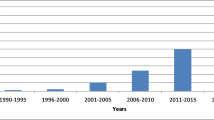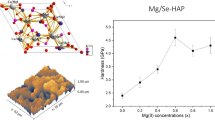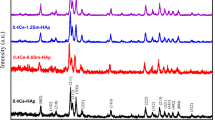Abstract
We report the synthesis of single-phase Fe-doped hydroxyapatite (HAp) [Ca10−xFe x (PO4)6(OH)2 (0.0 ≤ x ≤ 0.3)] and enhanced dielectric constant of HAp with Fe doping. Rietveld analysis shows the change in x-axis-oriented lattice constant a in Fe-doped x = 0.1 and 0.3 compositions in comparison with parent HAp, while z-axis-oriented lattice constant c does not show any considerable change. Analysis of absorbance data shows two new symmetric stretching peaks for Fe-doped x = 0.1 and x = 0.3 compositions, which are not present in parent HAp. Magnetic measurements show paramagnetic behaviour of all Fe-doped samples at 300 K. Fe-doped Ca9.9Fe0.1(PO4)6(OH)2 composition shows increase in impedance in the presence of 500 Oersted (Oe) applied magnetic field in comparison with impedance in the absence of magnetic field. Ca9.9Fe0.1(PO4)6(OH)2 composition shows increase in dielectric constant in comparison with parent HAp in frequency range 5–35 MHz. Fe-doped Ca9.9Fe0.1(PO4)6(OH)2 composition shows ~ 970% colossal magnetoimpedance at 100 Hz and ~ 200% at 20 MHz frequency.







Similar content being viewed by others
References
Kay M, Young R, Posner A (1964) Crystal structure of hydroxyapatite. Nature 204:1050–1052
Han GG, Lee S, Kim DW, Kim DH, Noh JH, Park JH, Roy S, Ahn TK, Jung HS (2013) A simple method to control morphology of hydroxyapatite nano- and microcrystals by altering phase transition route. Cryst Growth Des 13:3414–3418
Inoue K, Sassa K, Yokogawa Y, Sakka Y, Okido M, Asai S (2003) Control of crystal orientation of hydroxyapatite by imposition of a high magnetic field. Mater Trans 44:1133–1137
Mahabole M, Aiyer R, Ramakrishan C, Sreedhar B, Khaimar R (2005) Synthesis, characterization and gas sensing property of hydroxyapatite ceramic. Bull Mater Sci 28:535–545
Jevtic M, Mitric M, Skapin S, Jancar B, Ignjatovic N, Uskokovic D (2008) Crystal structure of hydroxyapatite nanorods synthesized by sonochemical homogeneous precipitation. Cryst Growth Des 8:2217–2222
Singh B, Dubey AK, Kumar S, Saha N, Basu B, Gupta R (2011) In vitro biocompatibility and antimicrobial activity of wet chemically prepared Ca10−xAgx(PO4)6(OH)2 (0.0 ≤ x ≤ 0.5) hydroxyapatites. Mater Sci Eng, C 31:1320–1329
Boanini E, Gazzano M, Bigi A (2010) Ionic substitutions in calcium phosphates synthesized at low temperature. Acta Biomater 6:1882–1894
Ning CQ, Zhou Y (2002) In vitro bioactivity of a biocomposite fabricated from HA and Ti powders by powder metallurgy method. Biomaterials 23:2909–2915
Goodwin CB, Brighton CT, Guyer RD, Johnson JR, Light KI, Yuan HA (1999) A double-blind study of capacitively coupled electrical stimulation as an adjunct to lumbar spinal fusions. Spine 24:1349–1356
Scott G, King JB (1994) A prospective, double-blind trial of electrical capacitive coupling in the treatment of non-union of long bones. J Bone Joint Surg Am 76:820–826
Yamashita K (2003) Enhanced bioactivity of electrically poled hydroxyapatite ceramics and coatings. Mater Sci Forum 426:3237–3242
Otter MW, McLeod KJ, Rubin CT (1998) Effects of electromagnetic fields in experimental fracture repair. Clin Orthop Relat Res 335:S90–S112
Xue W, Moore JL, Hosick HL, Bose S, Bandyopadhyay A, Lu W, Cheung KM, Luk KD (2006) Osteoprecursor cell response to strontium-containing hydroxyapatite ceramics. J Biomed Mater Res A 79:804
Singh B, Kumar S, Basu B, Gupta R (2013) Enhanced ionic conduction in hydroxyapatites. Mater Lett 95:100–102
Singh B, Kumar S, Basu B, Gupta R (2015) Conductivity studies of silver-, potassium-, and magnesium-doped hydroxyapatite. Int J Appl Ceram Technol 12:319–328
Singh B, Kumar S, Saha N, Basu B, Gupta R (2015) Phase stability of silver particles embedded calcium phosphate bioceramics. Bull Mater Sci 38:525–529
Kim TN, Feng QL, Kim JO, Wu J, Wang H, Chen GC, Cui FZ (1998) Antimicrobial effects of metal ions (Ag+, Cu2+, Zn2+) in hydroxyapatite. J Mater Sci Mater Med 9:129–134
Bose S, Fielding G, Tarfer S, Bandypadhyay A (2013) Understanding of dopant-induced osteogenesis and angiogenesis in calcium phosphate ceramics. Trends Biotechnol 31:594–605
Williams R (1968) Role of transition metal ions (1/26) in biological processes. R Inst Chem Rev 1:13–38
Xu H, Aguilar ZP, Yang LKM, Duan HXY, Wei H, Wang A (2011) Antibody conjugated magnetic iron oxide nanoparticles for cancer cell separation in fresh whole blood. Biomaterials 32:9758–9765
Na HB, Song IC, Hyeon T (2009) Inorganic nanoparticles for MRI contrast agents. Adv Mater 21(2009):2133–2148
Pankhurst QA, Conolly J, Jones S, Dobson J (2003) Applications of magnetic nanoparticles in biomedicine. J Phys D Appl Phys 36:R167
Veiseh O, Gunn JW, Zhang M (2010) Design and fabrication of magnetic nanoparticles for targeted drug delivery and imaging. Adv Drug Deliv Rev 62:284–304
Soenen SJ, Himmelreich U, Nuytten N, Cuyper MD (2011) Cytotoxic effects of iron oxide nanoparticles and implications for safety in cell labelling. Biomaterials 32:195–205
Singh B (2015) Structural, transport, magnetic and magnetoelectric properties of CaMn1−xFe x O3−δ (0.0 ≤ x ≤ 0.4). RSC Adv 5:39938–39945
Singh B (2015) Room temperature large positive and negative magnetocapacitance in CaMn0.95Fe0.05O3−δ. Mater Lett 156:76–78
Singh B (2016) Ru4+ induced colossal magnetoimpedance in Ru doped perovskite manganite at room temperature. Phys Chem Chem Phys 18:12947–12951
Chandra VS, Baskar G, Suganthi RV, Elayaraja K, Joshy MIA, Beaula WS, Mythili R, Venkatraman G, Kalkura SN (2012) Blood compatibility of iron-doped nanosize hydroxyapatite and its drug release. ACS Appl Mater Interfaces 4:1200–1210
Kramer E, Staruch M, Morey-Oppenheim A, Jain M, Budnick J, Suib S, Wei M (2013) synthesis and characterization of iron substituted hydroxyapatite via a simple ion-exchange procedure. J Mater Sci 48:665–673. https://doi.org/10.1007/s10853-012-6779-2
Panseri S, Cunha C, D’Alessandro T, Sandri M, Giavaresi G, Marcacci M, Hung CT, Tampieri A (2012) Intrinsically superparamagnetic Fe-hydroxyapatite nanoparticles positively influence osteoblast-like cell behaviour. J Nanobiotechnol 10:32
Zilm ME, Staruch M, Jain M, Wei M (2014) An intrinsically magnetic biomaterial with tunable magnetic properties. J Mater Chem B 2:7176–7185
Arends J, Christoffersen J, Christoffersen MR, Eckert H, Fowler BO, Heughebaert JC, Nancollas GH, Yesinowski JP, Zawacki SJ (1987) A calcium hydroxyapatite precipitated from an aqueous solution: an international multimethod analysis. J Cryst Growth 84:515–532
Chaudhry AA, Haque S, Kellici S, Boldrin P, Rehman I, Khalid FA, Darr JA (2006) Instant nano-hydroxyapatite: a continuous and rapid hydrothermal synthesis. Chem Commun 0:2286–2288
Kaygilia O, Dorozhkin SV, Ates T, Al-Ghamdi AA, Yakuphanoglua F (2014) Dielectric properties of Fe doped hydroxyapatite prepared by sol–gel method. Ceram Int 40:9395–9402
Tampieri A, D’Alessandro T, Sandri M, Sprio S, Landi E, Bertinetti L, Panseri S, Pepponi G, Goettlicher J, Bañobre-López M, Rivas J (2012) Intrinsic magnetism and hyperthermia in bioactive Fe-doped hydroxyapatite. Acta Biomater 8:843–851
Li Y, Widodo J, Lim S, Ooi CP (2012) Synthesis and cytocompatibility of manganese(II) and iron(III) substituted hydroxyapatite nanoparticles. J Mater Sci 47:754–763. https://doi.org/10.1007/s10853-011-5851-7
Mene RU, Mahabole MP, Mohite KC, Khairnar RS (2014) Improved gas sensing and dielectric properties of Fe doped hydroxyapatite thick films: effect of molar concentrations. Mater Res Bull 50:227–234
Antonakos A, Liarokapis E, Leventouri T (2007) Micro-Raman and FTIR studies of synthetic and natural apatites. Biomaterials 28:3043–3054
Fowler BO (1974) Infrared studies of apatites. I. Vibrational assignments for calcium, strontium, and barium hydroxyapatites utilizing isotopic substitution. Inorg Chem 13:194–204
Geng Z, Cui Z, Li Z, Zhu S, Liang Y, Lu WW, Yang X (2015) Synthesis, characterization and the formation mechanism of magnesium- and strontium-substituted hydroxyapatite. J Mater Chem B 3:3738–3746
Aza PND, Guitian F, Santos C, Aza SD, Cusco R, Artus L (1997) Vibrational properties of calcium phosphate compounds. 2. Comparison between hydroxyapatite and β-tricalcium phosphate. Chem Mater 9:916–922
Phan M, Peng H (2008) Giant magnetoimedance materials: fundamentals and applications. Prog Mater Sci 53:323–420
Ipatov M, Zhukova V, Zhukov A, Gonzalez J (2016) Current controlled switching of impedance in magnetic conductor with tilted anisotropy easy axis and its applications. Sci Rep 6(1–8):36180
Acknowledgements
B. Singh and A. Tandon thank University Grants Commission—Department of Atomic Energy, Consortium for Scientific Research (UGC-DAE, CSR), Indore Centre, India for providing facility for experiments and financial support to visit Indore centre. B. Singh also thanks Dr. Mukul Gupta, UGC-DAE, CSR, Indore centre for his help in collecting XRD data and Dr. R. J. Choudhary, UGC-DAE, CSR, Indore centre for magnetic measurements. Authors declare that there are no conflicts of interest.
Author information
Authors and Affiliations
Corresponding author
Rights and permissions
About this article
Cite this article
Singh, B., Tandon, A., Pandey, A.K. et al. Enhanced dielectric constant and structural transformation in Fe-doped hydroxyapatite synthesized by wet chemical method. J Mater Sci 53, 8807–8816 (2018). https://doi.org/10.1007/s10853-018-2225-4
Received:
Accepted:
Published:
Issue Date:
DOI: https://doi.org/10.1007/s10853-018-2225-4




